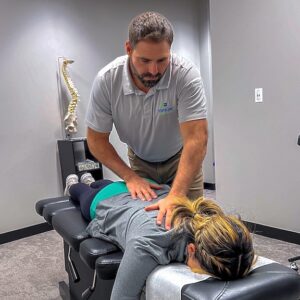Sciatica, a painful condition caused by compression of the sciatic nerve, can significantly disrupt daily life. While seeking relief, many consider Chiropractic Services care a viable solution. Understanding when to seek a chiropractor and the services they provide can be pivotal in finding relief from sciatica.
Understanding Sciatica:
Sciatica manifests as radiating pain from the lower back down to the legs, often accompanied by tingling or numbness. It stems from various factors like herniated discs, spinal stenosis, or even muscular issues.
Role of Chiropractic Care:
Chiropractors specialize in treating musculoskeletal issues, including sciatica, through non-invasive techniques. Their focus lies in spinal adjustments and manipulations to alleviate nerve pressure, reducing sciatic pain.
When to Consider a Chiropractor:
1. Persistent Pain Beyond Self-Care:
Persistent sciatic pain despite attempting self-care measures, such as rest, hot or cold therapy, and over-the-counter pain medications, could indicate the need for chiropractic intervention. If the pain persists for several weeks or worsens, consulting a chiropractor is advisable.
2. Impact on Daily Activities:
When sciatic pain starts interfering significantly with everyday activities like walking, standing, or sitting, it’s a sign that professional help may be necessary. Chiropractors can assess the severity and source of the pain, creating tailored treatment plans to alleviate discomfort.
3. Recurring Episodes of Sciatica:
Individuals experiencing recurrent episodes of sciatica, where the pain subsides but returns intermittently, should consider chiropractic care. This pattern might indicate an underlying issue that needs to be addressed to prevent future flare-ups.
4. Radiating Pain and Numbness:
Sciatica often presents as radiating pain from the lower back down to the legs, sometimes accompanied by tingling or numbness. If these sensations persist or worsen, it’s crucial to seek professional evaluation to prevent potential nerve damage.
5. Difficulty in Mobility or Weakness:
Weakness or difficulty in moving the affected leg or foot, coupled with sciatic pain, could signal nerve compression. Chiropractors specialize in identifying and addressing such issues through targeted adjustments and rehabilitation exercises.
6. History of Spinal Issues or Injuries:
Individuals with a history of spinal issues, injuries, or conditions such as herniated discs might be more susceptible to sciatica. If previous spinal problems contribute to current discomfort, consulting a chiropractor can offer specialized care focused on spinal health.
7. Lack of Improvement with Other Treatments:
If alternative treatments or therapies like physical therapy, medication, or acupuncture haven’t provided significant relief, seeking chiropractic care becomes a viable option. Chiropractors offer distinct techniques aimed at addressing the root cause of sciatic pain.
8. Pre-existing Health Conditions:
Those with pre-existing health conditions, such as arthritis or degenerative disc disease, might experience sciatica as a result. In such cases, chiropractic care can provide tailored approaches to manage the condition and alleviate associated discomfort.
Chiropractic Techniques for Sciatica:
Flexion-Distraction Technique: This technique involves a specialized chiropractic table designed to distract and flex the spine gently. By applying rhythmic, controlled motions, this method aims to widen the spinal canal, reduce disc bulging, and alleviate nerve root compression. It’s particularly effective for addressing lumbar disc herniation contributing to sciatic pain. Patients often experience relief due to decreased pressure on the affected nerve roots and improved mobility in the lower back and legs.
Pelvic Blocking: Chiropractors utilize specific wedge-shaped blocks placed strategically under the patient’s pelvis to address pelvic misalignments contributing to sciatica. By applying gentle pressure and realigning the pelvis, this technique helps reduce asymmetry and correct imbalances in the pelvis, subsequently alleviating nerve compression and easing sciatic pain.
Instrument-Assisted Manipulation: Some chiropractors use handheld instruments to perform precise and gentle spinal adjustments. These tools deliver controlled force to specific areas of the spine, aiming to correct misalignments contributing to sciatica. This technique is particularly beneficial for patients who prefer a more subtle, low-force approach to address their sciatic discomfort.
Myofascial Release Techniques: Chiropractors employ various soft tissue manipulation techniques to alleviate muscular tension surrounding the sciatic nerve. By targeting tight or inflamed muscles, chiropractors aim to release tension and adhesions, reducing pressure on the nerve and providing relief from sciatic pain. Techniques such as trigger point therapy, massage, and stretching may be employed to enhance flexibility and reduce muscular constriction.
Active Release Technique (ART): ART involves applying precise tension to soft tissues while patients move through specific motions. Chiropractors use their hands to manipulate muscles, ligaments, and tendons, aiming to break up adhesions and scar tissue along the nerve pathway. By restoring proper motion and reducing soft tissue restrictions around the sciatic nerve, ART helps improve flexibility and alleviate pain associated with sciatica.
Ultrasound Therapy: This technique involves the application of high-frequency sound waves to the soft tissues surrounding the affected area. The heat generated by ultrasound therapy increases blood flow, relaxes muscles, and accelerates the healing process. By reducing inflammation and promoting tissue repair, ultrasound therapy complements other chiropractic treatments, aiding in the management of sciatic pain.
Electrical Muscle Stimulation (EMS): EMS employs electrical currents to stimulate muscles and nerves. This therapy helps reduce muscle spasms, enhance blood circulation, and promote healing. By applying controlled electrical impulses, chiropractors aim to alleviate muscular tension, thereby reducing pressure on the sciatic nerve and providing relief from associated pain and discomfort.
Trigger Point Therapy: Chiropractors use this technique to identify and address specific trigger points associated with sciatic pain. By applying focused pressure to these areas, they aim to release tension and deactivate trigger points, reducing referred pain and discomfort along the path of the sciatic nerve. Trigger point therapy helps alleviate muscle knots and tightness, contributing to overall relief from sciatica.
Gonstead Technique: The Gonstead technique involves a detailed assessment of the spine, including X-rays and precise evaluations to identify misalignments contributing to sciatica. Chiropractors use specific adjustments tailored to each patient’s unique spinal anatomy to correct subluxations and realign the spine. This approach aims to reduce nerve interference and restore proper nerve function, addressing the underlying cause of sciatic pain.
McKenzie Method: Chiropractors trained in the McKenzie Method prescribe targeted exercises and movements designed to centralize and alleviate sciatic pain. By guiding the disc material away from the nerve roots, this method aims to reduce pressure on the nerve and promote healing. Patients are provided with specific exercises to perform at home, aiding in the reduction of sciatic symptoms and improving overall spinal health.
Benefits of Chiropractic Care:
Non-Invasive Pain Relief: Chiropractic care offers a non-invasive approach to alleviating sciatic pain. Unlike surgical interventions, which may carry inherent risks and prolonged recovery periods, chiropractic techniques such as spinal adjustments and manipulations provide a gentle yet effective means of pain relief. By precisely targeting the affected area, chiropractors help realign the spine and reduce nerve pressure, addressing the root cause of sciatica without invasive procedures.
Holistic Approach to Wellness: Beyond mere pain management, chiropractic care adopts a holistic perspective toward overall wellness. Chiropractors view the body as an interconnected system, recognizing that sciatica can result from various factors beyond localized pain. They emphasize lifestyle adjustments, including advice on nutrition, exercise, and ergonomic practices, considering these elements as essential components in fostering comprehensive well-being and aiding in sciatica relief.
Reduced Reliance on Medication: A significant advantage of chiropractic care lies in its approach to minimizing reliance on pharmaceuticals for pain management. By employing natural, drug-free methods, chiropractors aim to reduce or eliminate the need for pain medications, which often come with potential side effects and the risk of dependency. Through targeted adjustments and therapies, patients can experience effective pain relief without the drawbacks associated with long-term medication usage.
Individualized Treatment Plans: Chiropractic care stands out for its personalized approach to addressing sciatica. Chiropractors conduct thorough assessments, taking into account each patient’s unique medical history, lifestyle factors, and the specific manifestations of sciatic pain. They then design tailored treatment plans, incorporating various techniques and therapies to suit the individual’s needs. This personalized approach enhances the effectiveness of the treatment and improves the likelihood of successful outcomes.
Improved Range of Motion: Sciatica often results in limited mobility due to pain and discomfort. Chiropractic interventions, such as spinal adjustments, targeted exercises, and rehabilitation strategies, focus on restoring proper spinal alignment and functionality. By addressing underlying issues causing restricted movement, chiropractic care aims to enhance range of motion, enabling patients to perform daily activities with greater ease and comfort.
Enhanced Nervous System Function: Misalignments in the spine can adversely affect the nervous system, exacerbating sciatic nerve irritation and associated pain. Chiropractic adjustments specifically target these misalignments, thereby reducing interference to the nervous system. By promoting better nerve function and communication between the brain and body, chiropractic care plays a pivotal role in reducing sciatic pain and improving overall neural health.
Preventive Care Emphasis: Chiropractic care extends beyond treating existing ailments; it emphasizes preventive measures for long-term spinal health. Regular chiropractic sessions not only address current issues but also help maintain spinal alignment, strengthen supporting musculature, and potentially prevent future injuries or episodes of sciatic pain. This proactive approach fosters resilience against recurring issues, promoting sustained well-being.
Enhanced Sleep Quality: Sciatica can significantly disrupt sleep patterns due to persistent discomfort. Chiropractic care, by alleviating pain and improving overall physical health, can contribute to enhanced sleep quality. By reducing pain and optimizing spinal alignment, chiropractic treatments may facilitate more restful and rejuvenating sleep, promoting overall wellness.
Supports Natural Healing: Chiropractic care emphasizes the body’s innate ability to heal itself. By addressing the underlying cause of sciatica through adjustments and therapeutic modalities, chiropractors assist the body in its natural healing process. These interventions aid in repairing damaged tissues, restoring optimal function, and facilitating the body’s inherent healing mechanisms for sustained relief.
Patient Education and Empowerment: A fundamental aspect of chiropractic care involves patient education and empowerment. Chiropractors educate patients on proper posture, ergonomic practices, rehabilitative exercises, and lifestyle modifications that complement the treatment. This educational component empowers individuals to actively participate in their recovery, fostering a sense of control and accountability in managing their spinal health for long-term well-being.
What to Expect in Chiropractic Sessions:
Initial consultations involve discussing medical history, conducting physical examinations, and determining a personalized treatment plan. Sessions typically include adjustments and may involve additional therapies depending on the severity of sciatica.
Choosing chiropractic care for sciatica relief can be a proactive step towards managing and alleviating the discomfort caused by this condition. By understanding when to seek a chiropractor, exploring available techniques, and finding the right practitioner, individuals can embark on a path towards sciatic pain relief and improved quality of life.
2644 W Schaumburg Rd, Schaumburg, IL 60194, United States
847-278-1574
https://myevolvechiropractor.com/locations/chiropractor-west-schaumburg-il/





